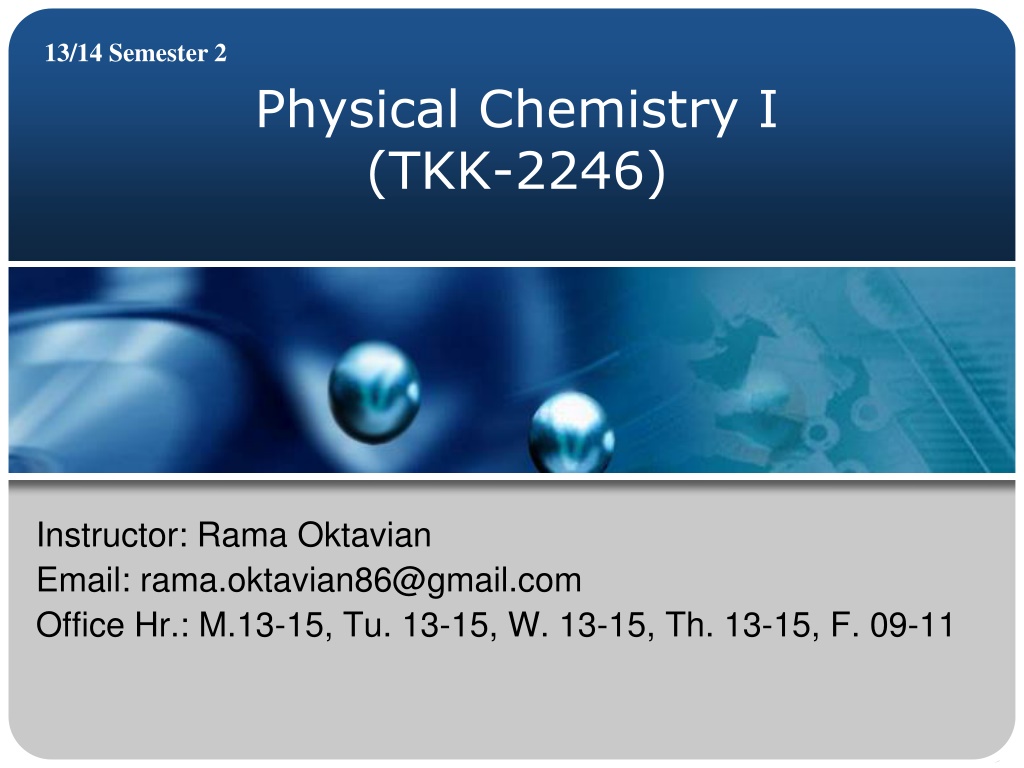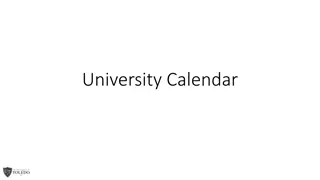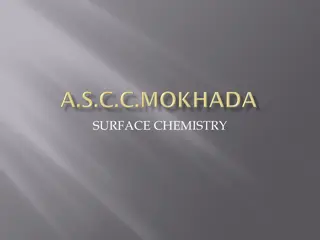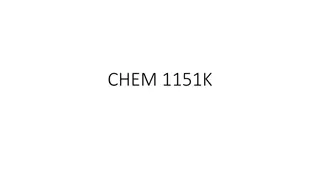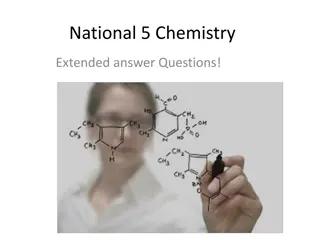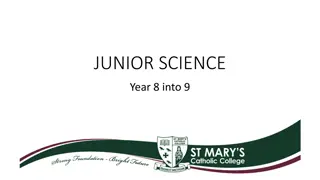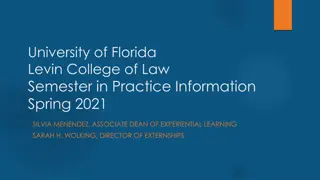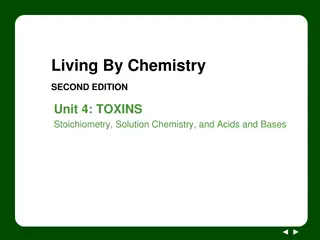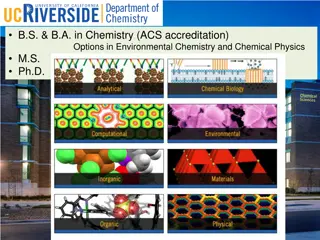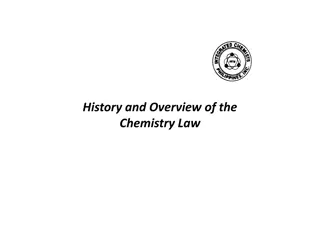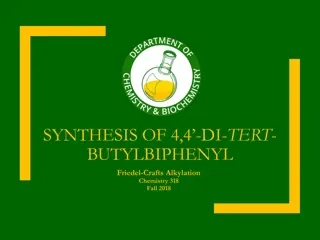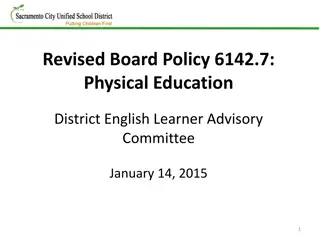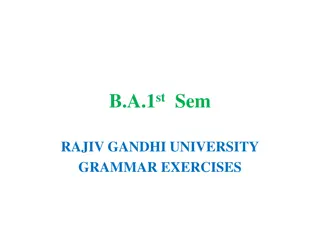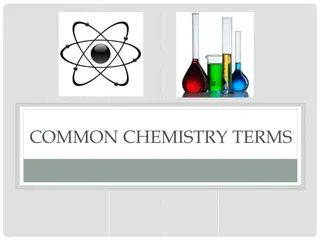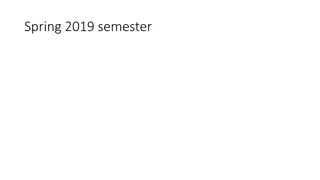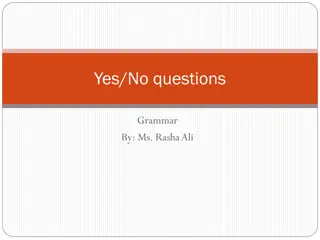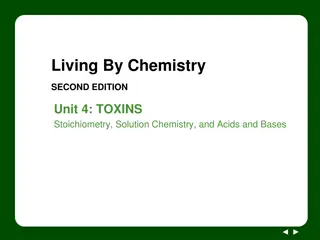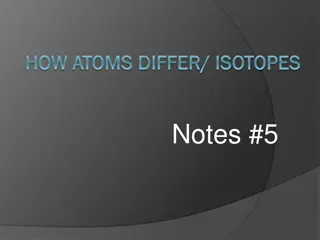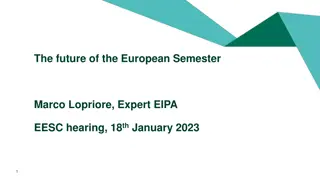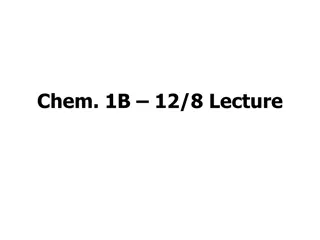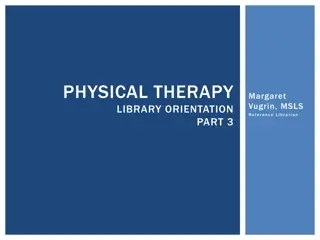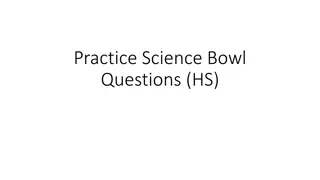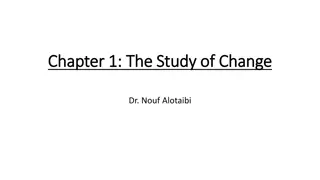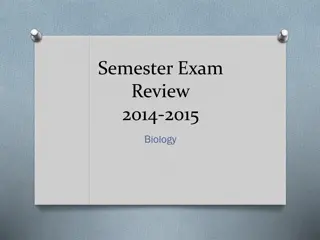Physical Chemistry I - Semester 2 Outlines and Practice Questions
Dive into Physical Chemistry I with this detailed outline covering topics such as molar mass of gas, gas mixtures, and ideal gas equations. Practice questions on gas pressure, volume, and temperature relationships are included for self-assessment. Learn how to calculate molar mass, determine gas density, and solve problems involving ideal gases. Enhance your understanding of key concepts in physical chemistry with this comprehensive study material.
Download Presentation

Please find below an Image/Link to download the presentation.
The content on the website is provided AS IS for your information and personal use only. It may not be sold, licensed, or shared on other websites without obtaining consent from the author. Download presentation by click this link. If you encounter any issues during the download, it is possible that the publisher has removed the file from their server.
E N D
Presentation Transcript
13/14 Semester 2 Physical Chemistry I (TKK-2246) Instructor: Rama Oktavian Email: rama.oktavian86@gmail.com Office Hr.: M.13-15, Tu. 13-15, W. 13-15, Th. 13-15, F. 09-11
Outlines 1. Review 2. Molar mass of gas 3. Molar mass of volatile component 4. Gas mixture
Review Learning check Learning check A sealed flask with a capacity of 1 dm3 contains 5 g of ethane. The flask is so weak that it will burst if the pressure exceeds 1 MPa. At what temperature will the pressure of the gas reach the bursting pressure ?
Review Learning check Learning check A perfect gas undergoes isothermal compression, which reduces its volume by 1.80 dm3. The final pressure and volume of the gas are 1.97 bar and 2.14 dm3, respectively. Calculate the original pressure of the gas in (a) bar, (b) Torr
Review Learning check Learning check A large cylinder for storing compressed gases has a volume of about 0.050 m3. If the gas is stored under a pressure of 15 MPa at 300 K, how many moles of gas are contained in the cylinder ? What would be the mass of oxygen in such a cylinder ?
Review Learning check Learning check A manometer consists of a U-shaped tube containing a liquid. One side is connected to the apparatus and the other is open to the atmosphere. The pressure inside the apparatus is then determined from the difference in heights of the liquid. Suppose the liquid is water, the external pressure is 770 Torr, and the open side is 10.0 cm lower than the side connected to the apparatus. What is the pressure in the apparatus? (The density of water at 25 C is 0.99707 g cm 3.)
Molar mass of ideal gas Determination of molar mass for ideal gas Determination of molar mass for ideal gas Ideal gas equation PV = nRT w n = M Intensive properties and measurable w RT = = M RT V P P
Molar mass of ideal gas Determination of molar mass for ideal gas Determination of molar mass for ideal gas Gas density w RT = = M RT V P P Density is higher 1. for gases with a higher molar mass Gases 2. at higher pressures 3. at lower temperatures
Molar mass of ideal gas Determination of molar mass for ideal gas Determination of molar mass for ideal gas Example if chemical analysis of a gas yields an empirical formula (CH 2 )n, then the molar mass must be some multiple of 14 g/mol ; the possibilities are 28, 42, 56, 70, and so on. If a molar mass determination using Eq. (2. 20) yields a value of 54 g/mol, then we may conclude that n = 4 and that the material is one of the butenes.
Molar mass of ideal gas Determination of molar mass for ideal gas Determination of molar mass for ideal gas Problem : Calculation of Molecular Weight of a Natural Gas - Methane A sample of natural gas is collected at 25.0 C in a 250.0 ml flask. If the sample had a mass of 0.118 g at a pressure of 550.0 torr, what is the molecular weight of the gas? Use the ideal gas law to calculate n, then calculate the molar mass.
Molar mass of ideal gas Determination of molar mass for ideal gas Determination of molar mass for ideal gas Problem At 100 C and 1.60 kPa, the mass density of phosphorus vapour is 0.6388 kg m 3. What is the molecular formula of phosphorus under these conditions?
Molar mass of ideal gas Determination of molar mass for ideal gas Determination of molar mass for ideal gas Problem A series of measurements are made in order to determine the molar mass of an unknown gas. First, a large flask is evacuated and found to weigh 134.567 g. It is then filled with the gas to a pressure of 735 torr at 31 C and reweighed; its mass is now 137.456 g. Finally, the flask is filled with water at 31 C and found to weigh 1067.9 g. (The density of the water at this temperature is 0.997 g/mL.) Assuming that the ideal-gas equation applies, calculate the molar mass of the unknown gas.
Gas mixture Air is an example of an ideal gas mixture and has the following approximate composition. Component N2 O2 Argon CO2 + trace elements % by Volume 78.10 20.95 0.92 0.03
Gas mixture Properties of gas mixture Properties of gas mixture k gases T = TmV = Vm P = Pmm = mm The total mass of the mixture mm and the total moles of mixture Nm are defined as k k = = and m m N N m i m i = = 1 1 i i
Gas mixture Properties of gas mixture Properties of gas mixture Volume concentration Unit : mol/m3 Volume concentration molarity
Gas mixture Properties of gas mixture Properties of gas mixture The composition of a gas mixture is described by specifying either the mass fraction mfior the mole fraction yiof each component i. m m N N = = and i i mf y i i m m Note that k k = =1 and 1 mf y i i = = 1 1 i i
Daltons law Ideal gas law for gas mixture Ideal gas law for gas mixture We define the partial pressure of each gas in the mixture as the pressure the gas would exert if it were alone in the container of volume V at temperature T
Daltons law Partial pressure Partial pressure Dalton s law
Daltons law Dalton s Law of Partial Pressures indicates that pressure depends on the total number of gas particles, not on the types of particles. the total pressure exerted by gases in a mixture is the sum of the partial pressures of those gases. PT = P1 + P2 + P3 +.....
Daltons law Partial pressures are simply related to the mole fractions of the gases in the mixture p n RT V 1= 1 p n RT V t
Daltons law Partial pressures are simply related to the mole fractions of the gases in the mixture
Daltons law Learning check Learning check If I place 3 moles of N2 and 4 moles of O2 in a 35 L container at a temperature of 25 C, what will the pressure of the resulting mixture of gases be? What s the partial pressure of carbon dioxide in a container that holds 5 moles of carbon dioxide, 3 moles of nitrogen, and 1 mole of hydrogen and has a total pressure of 1.05 atm?
Daltons law Learning check Learning check A vessel of volume 22.4 dm3contains 1.5 mol H2and 2.5 mol N2 at 273.15 K. Calculate (a) the mole fractions of each component, (b) their partial pressures, and (c) their total pressure
Daltons law Dalton s law application in atmosphere Dalton s law application in atmosphere This explains why people usually difficult to breathe in high altitude place even the concentration of oxygen is same (21%) The transfer of oxygen molecules from the lungs to the bloodstream is dependent on a pressure gradient.
Exercise and learning check Problems Problems Ch. 1 Atkin s Physical chemistry 8th ed. Numerical problems no: 1.4 1.5 1.6 Take-home assignment Theoretical problem 1.24 Chapter 2 Castellan Physical chemistry 3rd ed. Problems no: 2.9 2.13
